A Love Letter to Neville Hall
February 2016
In February, we celebrate Valentine’s Day, when friends, family members, and romantic partners find ways to express their love for one another. But it’s also possible to love a place, and even to feel that in some way the place returns that love! For many of us, Presbyterian College is that kind of place, and perhaps the building that most truly represents PC is Neville Hall. In honor of the Month of Love, here is a love letter to Neville Hall.
Presbyterian College had its humble beginnings in 1880 in a white frame building in Clinton, South Carolina. For its first 10 years, PC, then known as Clinton College, operated out of the Thornwell Orphanage campus. In 1890, the land for the current South Broad Street campus was donated to the college by the Young family, and the college began to grow. That year the college’s name was also formally changed to Presbyterian College. The first building constructed on the new campus was Alumni Hall followed by the original dining hall, the professor’s cottage and dormitory, and the first president’s house (sadly, none of these buildings is standing any longer). However, while students lived on the new campus, classes were still being held in Recitation Hall on the Thornwell campus.
By the early 1900s, PC’s need for a new academic building was clear, both for additional space and to consolidate all college activities at one location. Plans began taking shape, and in June 1906, Presbyterian College founder William Plumer Jacobs noted in Our Monthly that “the college administration is moving forward rapidly. The building is a large one and will cost $25,000.”
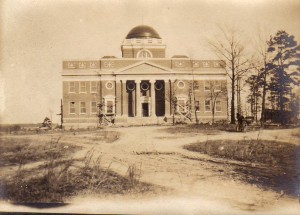
PC’s new administration building, eventually renamed Neville Hall, was opened in 1907, becoming the first academic building on PC’s current campus. The building was designed by noted Columbia architect Charles Coker Wilson and was built on the highest point of PC’s campus, making it the campus’s focal point, which it has remained to this day. It was completed in 8 months at cost of $35,000, a bit more than Dr. Jacobs’ original prediction. When it was opened, the building housed classrooms, science labs, literary society halls (later used for fraternity meeting spaces), the college library, campus offices, and a second-floor auditorium with seating for 450 people.
In 1944, the building’s name was changed to Neville Hall in honor of W. G. Neville, president of the college from 1904 to 1907. In 1965-66, the building underwent a $375,000 renovation, the first of two major renovations. Air conditioning was installed, which was a very welcome development for students, faculty, and staff. The other major change was the creation of more classroom and office space. This was accomplished by suspending a floor on steel beams in the old auditorium and suspending three floors in the open space leading from the central rotunda into the top of the dome.
Of course, this meant that Neville Hall’s lovely open dome had to be enclosed. It is relatively easy for us today to look back on this decision and wonder, “How could they have done that?” In hindsight, as we prepare to restore Neville to its original open-dome state, it is easy to criticize such action as short-sighted. However, a search of archives files from the mid-1960s, including The Blue Stocking and Board of Trustees minutes, has yielded no indication that the renovation was controversial at the time. Moreover, it’s important to remember that this renovation provided the campus with additional badly-needed office and classroom space and was an eminently practical solution to the pressures created by PC’s rapid growth in the 1960s. As Ben Hay Hammet noted in Spirit of PC: A Centennial History of Presbyterian College, “[b]y 1965, a tidal wave of students flowed toward the nation’s colleges. The numbers seeking to enter Presbyterian doubled over the previous year” (p. 140). Hammet also noted that the renovation of Neville “added considerable vitality to the academic program” (p. 142).
In 1988, another renovation of Neville took place. A new roof and windows were installed, a second staircase from the third to the fourth floor was added, new front steps were put in, and a handicapped-accessible entrance was added. Since then, other than some work on classrooms and corridors in 1992, little has changed in Neville Hall. Throughout its history, the building, particularly its dome, has remained one of Presbyterian College’s most recognizable representations. Neville Hall is part of the memories of every student who has passed through PC’s campus. It has seen student gatherings.
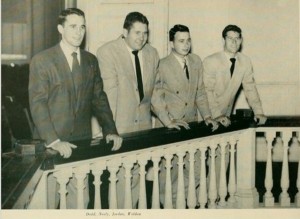
It has seen pranks.
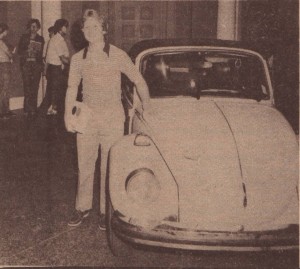
It has seen generations of students inside, and sometimes outside, its classrooms.
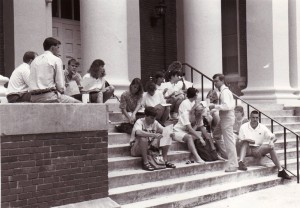
In fact, no student has graduated from PC without taking classes in Neville – as PC Professor Emeritus of English Neal Prater noted recently, students HAD to take religion, a foreign language, and history, all taught in Neville Hall. “And best of all,” Dr. Prater continued, “they GOT to take English, taught in Neville Hall.“ It is, therefore, fitting that this symbol of the college be granted some much-needed tender, loving care.
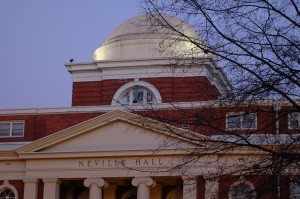
On Friday, October 16 of last year, PC faculty, staff, students, alumni, and friends gathered in front of Neville Hall for the Neville Renewed Campaign Kickoff event. We heard reminiscences from alumni and former and current faculty members (including Dr. Prater, quoted above), all sharing their thoughts about Neville Hall as the heart of PC’s campus. Professor of History Anita Gustafson reminded us that “a renewed Neville will allow PC to take the values that have historically made this place strong, and bring them into the future. A renewed Neville is a vote of support for the humanities, the liberal arts, and most importantly, for the very heart – and soul and mind – of Presbyterian College.” Together those gathered drank a toast to celebrate our shared vision of a Neville Hall restored to its past splendor, yet also equipped with the technology of the 21st century, as its hallowed halls continue to house the legacy of the last 108 years.

posted by Sarah Leckie
